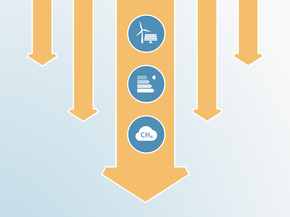Country summary
Overview
The Norwegian government is taking some big steps on climate, but it still has a way to go. In February 2020, Norway submitted its enhanced Paris Agreement target (NDC), which sets a target of reducing emissions by at least 50% and towards 55% below 1990 levels by 2030. If the European Union’s enhanced NDC sets a less ambitious target than Norway, the government intends to achieve the difference between its own target and that of the EU through voluntary cooperation under Article 6 of the Paris Agreement. The CAT rates this target as “Insufficient”.
We expect current policy emissions in 2020 to be 5% to 9% lower than in 2019 due to COVID-19 impacts in economy and activity levels. The Norwegian government presented an economic recovery package of USD 2.8 billion (NOK 27 billion). This includes tax relief for oil and gas companies, which economists warn could lead to Norway extracting oil and gas for a longer period than previously expected. The aviation industry also received substantial financial support, without any conditions on improving the sector’s climate impact. Only USD 375 million (NOK 3.6 billion) of the recovery package is reserved for green measures, including research and development of green technologies.
In May 2020, the Norwegian Central Bank decided to divest from Glencore, Anglo-American and RWE for their coal activities. This followed a June 2019 decision when the Norwegian Parliament voted to extend divestment policies that will see its huge Government Pension Fund (also known as the Oil Fund) not only phase out investments in companies dealing with oil and gas exploration and production, but also divest from eight coal companies. The policies include a ban on the Fund investing in any company generating more than 10GW of electricity from coal - or mining more than 20 million tonnes of coal annually. Some of the resources will instead be invested in unlisted renewable energy projects.
Norway continues to lead the world with its record share of electric cars: in 2019 the share of electrically-charged vehicles sold in the country increased to 42%. However, the overall figure is still at around 10% of all cars.
Norway’s long term, 2050 goal of becoming a “low-carbon society” was engrained in the Climate Change Act in 2017, described as an 80-95% reduction below 1990 levels. In a January 2019 declaration, the government signalled its plans to increase this goal to a 90-95% emissions reduction, but as of June 2020, has not yet officially done so. Also, the government failed to clarify what share of reductions would be achieved domestically and what share through international offset credits.
Current policies are projected to lead to emission levels of 41-44MtCO2 by 2030, which is 14-21% below emissions in 1990. COVID-19 is likely to have only a very limited impact on future emission levels: our pre-COVID projections estimated that emissions would be at 45Mt by 2030.
Norway is one of the few countries that has submitted its updated NDC well in advance of the COP deadline and included a stronger emission reduction target for 2030 than the first NDC (at least 50-55% below 1990 levels, compared to a reduction of at least 40%). The new NDC does not include a reference to the carbon neutrality target for 2030, that was approved by the Norwegian parliament in 2016.
We rate Norway’s unconditional NDC “Insufficient,” and not consistent with limiting warming below 2°C, let alone with the Paris Agreement’s stronger 1.5°C limit, unless other countries make much deeper reductions and comparably greater effort.


Norway’s electricity generation is almost exclusively renewable: in 2018, 95% of electricity was generated by hydro power plants and 2.6% from wind farms. Only 2.4% of generation was from thermal power plants, mostly in industrial heat processes.
Norway is home to the biggest hydrocarbon reserves in Europe, making it the world’s fifth largest exporter of crude oil, and its offshore drilling activities have been subject to a carbon tax since 1991. In 1999, these were increased, and in 2005 Norway joined the EU ETS. By 2018, around 80% of greenhouse gas emissions were taxed, with the highest tax charged on domestic aviation and mineral oil.
While the decarbonisation of Norway’s transport system is one of the three main goals of its National Transport Plan 2018–2029, the majority of the NOK 69.3 billion (USD 7.6 billion) allocated to the transport budget in 2020 still flowed into construction and improvement of roads and highways. However, there is a stated commitment to increase government spending on key public transport projects in the four largest urban areas and reduce ticket prices in the main cities.
In 2019 battery electric vehicles reached a 42% market share. The increasing share of electric cars in new sales has had an impact on the overall share of zero emissions vehicles: by February 2020, 10% of Norway’s car fleet was electric.
Norway has a substantial carbon sink in its forests - equal to around half of Norway’s annual emissions. Forest cover has been increasing. The volume of growing wood stock increased between 2008-2017 by over 23%. According to the national forestry accounting plan, Norway’s average annual removal from this sector will amount to slightly over 24 MtCO2eq between 2021-2025.
Norway has pledged up to NOK 3 billion (USD 343 million) a year in the framework of the Norway International Climate and Forest Initiative (NICFI) to reduce deforestation in other countries.
Further analysis
Latest publications
Stay informed
Subscribe to our newsletter




